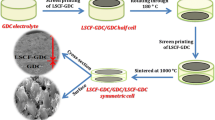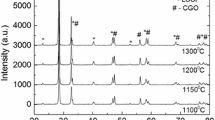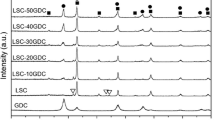Abstract
The ability for direct utilization of hydrocarbons had extended commercial applications of solid oxide fuel cells (SOFCs). In this regard, using ceramic materials instead of cermet composite anodes to overcome the carbon deposition and sulfur poisoning is a promising approach which improves stability of the cell in a hydrocarbon atmosphere. In this study, La0.75Sr0.25Cr0.5Mn0.5O3−δ/Zr0.92Y0.08O2-β (LSCM/YSZ) was used as a fully ceramic anode electrode for methanol oxidation reaction. In order to improve the electrode performance, infiltration of LaFe0.6Co0.4O3 (LFC) and LaFe0.58Co0.37Pd0.05O3 (LFCP) solutions onto the LSCM/YSZ composite backbone was investigated. Electrochemical impedance spectroscopy (EIS) was utilized for the characterization of pure and infiltrated cells. The results revealed that LSCM/YSZ has a large electrode polarization resistance for methanol oxidation reaction while introducing LFC nanoparticles onto the microstructure of ceramic anode significantly promoted the electrocatalytic activity of LSCM/YSZ electrode. For instance, electrode polarization resistance for the methanol oxidation reaction decreased significantly (~ 92%) after infiltration of 0.3 M LFC solution at 850 °C. Analyzing the impedance data using an equivalent circuit showed that LFC infiltration mainly enhanced the reaction active sites and impressively promoted the electrode processes at medium and low frequencies. Utilization of LFCP instead of LFC did not cause further enhancement in the performance of the electrode for methanol oxidation reaction.








Similar content being viewed by others
References
Lee KT, Wachsman ED (2014) Role of nanostructures on SOFC performance at reduced temperatures. MRS Bull 39:783–791
Ge XM et al (2012) Solid oxide fuel cell anode materials for direct hydrocarbon utilization. Adv Energy Mater 2:1156–1181
Atkinson A et al (2004) Advanced anodes for high-temperature fuel cells. Nat Mater 3:17–27
Sá S et al (2010) Catalysts for methanol steam reforming—a review. Appl Catal B Environ 99:43–57
Sengodan S et al (2018) Advances in reforming and partial oxidation of hydrocarbons for hydrogen production and fuel cell applications. Renew Sust Energ Rev 82:761–780
Su C et al (2015) Progress and prospects in symmetrical solid oxide fuel cells with two identical electrodes. Adv Energy Mater 5:1500188. https://doi.org/10.1002/aenm.201500188
Gan T et al (2019) Effects of manganese oxides on the activity and stability of Ni-Ce0. 8Sm0. 2O1. 9 anode for solid oxide fuel cells with methanol as the fuel. Catal Today 330:222–227
Gan T et al (2019) A LaNi0. 9Co0. 1O3 coated Ce0. 8Sm0. 2O1. 9 composite anode for solid oxide fuel cells fed with methanol. Catal Today 327:220–225
Huang Y-H et al (2006) Double perovskites as anode materials for solid-oxide fuel cells. Science 312:254–257
Marina OA et al (2002) Thermal, electrical, and electrocatalytical properties of lanthanum-doped strontium titanate. Solid State Ionics 149:21–28
Mahato N et al (2015) Progress in material selection for solid oxide fuel cell technology: a review. Prog Mater Sci 72:141–337
Boulfrad S et al (2015) Electrochemical impedance spectroscopy investigation of the anodic functionalities and processes in LSCM-CGO-Ni systems. ECS Trans 68:2011–2018
Gür TM (2016) Comprehensive review of methane conversion in solid oxide fuel cells: prospects for efficient electricity generation from natural gas. Prog Energy Combust Sci 54:1–64
Tao S, Irvine JT (2003) A redox-stable efficient anode for solid-oxide fuel cells. Nat Mater 2:320–323
Jiang SP et al (2008) Nanostructured palladium–La0.75Sr0.25Cr0.5Mn0.5O3/Y2O3–ZrO2 composite anodes for direct methane and ethanol solid oxide fuel cells. J Power Sources 185:179–182
Fowler DE et al (2015) Decreasing the polarization resistance of (La, Sr) CrO3− δ solid oxide fuel cell anodes by combined Fe and Ru substitution. Chem Mater 27:3683–3693
Babaei A et al (2010) Pd-promoted (La,Ca)(Cr,Mn)O3/GDC anode for hydrogen and methane oxidation reactions of solid oxide fuel cells. Solid State Ionics 181:1221–1228
Ye Y et al (2008) Pd-promoted La0. 75Sr0. 25Cr0. 5Mn0. 5O3/YSZ composite anodes for direct utilization of methane in SOFCs. J Electrochem Soc 155:B811–B818
Kim J-S et al (2011) A study of the methane tolerance of LSCM–YSZ composite anodes with Pt, Ni, Pd and ceria catalysts. Scr Mater 65:90–95
Jiang SP et al (2006) GDC-impregnated (La0. 75Sr0. 25)(Cr0. 5Mn0. 5) O3 anodes for direct utilization of methane in solid oxide fuel cells. J Electrochem Soc 153:A850–A856
Watanabe R et al (2011) Dehydrogenation of ethylbenzene over highly active and stable perovskite oxide catalyst–effect of lattice oxygen on/in perovskite oxide and role of A/B site in perovskite oxide. Appl Catal A Gen 398:66–72
Roseno K et al (2016) Investigation of LaCoO3, LaFeO3 and LaCo0.5 Fe0.5 O3 perovskites as catalyst precursors for syngas production by partial oxidation of methane. Int J Hydrog Energy 41:18178–18192
Khine MSS et al (2013) Syngas production by catalytic partial oxidation of methane over (La0.7 ,A0.3) BO3 (A= Ba, Ca, Mg, Sr, and B= Cr or Fe) perovskite oxides for portable fuel cell applications. Int J Hydrog Energy 38:13300–13308
Shen J et al (2016) Impregnated LaCo0.3 Fe0.67 Pd0.03 O3-δ as a promising electrocatalyst for “symmetrical” intermediate-temperature solid oxide fuel cells. J Power Sources 306:92–99
Khameneh MK, Babaei A (2019) Co-electrolysis of CO2 and H2O on LaFe0. 6Co0. 4O3 promoted La0. 75Sr0. 25Cr0. 5Mn0. 5O3/YSZ electrode in solid oxide electrolysis cell. Electrochim Acta 299:132–142
Varandili SB et al (2018) Characterization of B site codoped LaFeO3 nanoparticles prepared via co-precipitation route. Rare Metals 37:181–190
Jiang SP et al (2006) (La0.75 ,Sr0.25) (Cr0.5 ,Mn0.5) O3/YSZ composite anodes for methane oxidation reaction in solid oxide fuel cells. Solid State Ionics 177:149–157
Fu Q et al (2006) La0. 4Sr0. 6Ti1− x Mnx O3− δ perovskites as anode materials for solid oxide fuel cells. J Electrochem Soc 153:D74–D83
Robertson NL, Michaels JN (1991) Double layer capacitance of porous platinum electrodes in zirconia electrochemical cells. J Electrochem Soc 138:1494–1499
Jamnik J, Maier J (1999) Treatment of the impedance of mixed conductors equivalent circuit model and explicit approximate solutions. J Electrochem Soc 146:4183–4188
Primdahl S, Mogensen M (1998) Gas conversion impedance: a test geometry effect in characterization of solid oxide fuel cell anodes. J Electrochem Soc 145:2431–2438
Geisler H et al (2013) Model based interpretation of coupled gas conversion and diffusion in SOFC-anodes. ECS Trans 57:2691–2704
Jung I et al (2013) LSCM–YSZ nanocomposites for a high performance SOFC anode. Ceram Int 39:9753–9758
Kawada T et al (2002) Determination of oxygen vacancy concentration in a thin film of La0. 6Sr0. 4CoO3− δ by an electrochemical method. J Electrochem Soc 149:E252–E259
A. Ladavos and P. Pomonis, "Methane combustion on perovskites," Perovskites and related mixed oxides: concepts and applications, 2015.
Varandili SB et al (2018) Nano-structured Pd doped LaFe(Co)O3 perovskite; synthesis, characterization and catalytic behavior. Mater Chem Phys 205:228–239
Author information
Authors and Affiliations
Corresponding author
Additional information
Publisher’s note
Springer Nature remains neutral with regard to jurisdictional claims in published maps and institutional affiliations.
Rights and permissions
About this article
Cite this article
Rostaghi Chalaki, H., Babaei, A., Ataie, A. et al. LaFe0.6Co0.4O3 promoted LSCM/YSZ anode for direct utilization of methanol in solid oxide fuel cells. Ionics 26, 1011–1018 (2020). https://doi.org/10.1007/s11581-019-03248-2
Received:
Revised:
Accepted:
Published:
Issue Date:
DOI: https://doi.org/10.1007/s11581-019-03248-2




